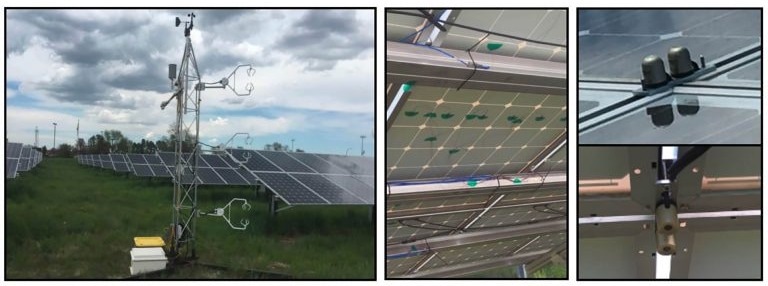Reviewed by Alex SmithNov 30 2022
As far as solar cells are concerned, a sunny, bright, cloudless day might look like the perfect setting. However, too much sun, and too much heat, have the potential to decrease photovoltaic efficiency.
 Real-world data from monitoring equipment at the Denver Federal Center was used to investigate how the spacing between solar panels can help them cool down. Image Credit: Smith et al.
Real-world data from monitoring equipment at the Denver Federal Center was used to investigate how the spacing between solar panels can help them cool down. Image Credit: Smith et al.
As the operating temperature of these cells increases by 1°C, conventional silicon-based solar cells will lose around 0.5% efficiency. In a normal photovoltaic plant, where modules tend to function around 25°C above the ambient temperature, energy losses have the potential to reach around 12%.
This demands efficient cooling measures for solar farms. In the Journal of Renewable and Sustainable Energy, scientists from Portland State University, the University of Utah, and the National Renewable Energy Laboratory examined how to use solar farms' geometry to improve natural cooling mechanisms.
Few modern cooling techniques force wind or water to cooperate with solar panel surfaces, while others utilize particular materials with less thermal sensitivity. But such methods need considerable resources to function. On the other hand, a solar farm with optimally spaced panels experiencing the proper direction could cool itself via convection with the help of the encircling wind.
The research group enhanced models that evaluate how much energy a provided solar plant will produce depending on the material, panel temperature, and environmental conditions. Particularly, they concentrated on the solar farms’ geometry, or how much so-called “gappy-ness” existed between the panels.
Our hypothesis was that the most precise estimate of solar plant convection, and ultimately production efficiency, must consider the farm as a whole and all possible configuration changes.
Sarah Smith, Study Author, Portland State University
By design, it is unusual that any two solar plants have a similar setup. Each has been uniquely developed to improve solar irradiance and conform to its encircling surrounding. For instance, the incline of solar panels varies with latitude, and their height changes with vegetation. Frequently, the spacing of rows relies on how much land is accessible.
This means that the heat-removing wind flow will also move differently throughout each solar plant based on its arrangement, ultimately changing how efficiently heat is removed from module surfaces.
Sarah Smith, Study Author, Portland State University
The scientists executed wind tunnel experiments and high-resolution simulations and gathered real-world data to verify their model. They analyzed photo voltaic heating and cooling with changes in module height, row spacing, angle, and wind. Increasing the height of solar cells and increasing the spacing between panel rows raised power output by 2% to 3%.
This correlation between geometry and efficiency is a huge step toward predicting convective cooling for solar farms based on their inherently unique arrangements. It paves the way for more accurate energy generation and cost prediction models in industry.
Sarah Smith, Study Author, Portland State University
Journal Reference:
Smith, S. E., et al. (2022) Viewing convection as a solar farm phenomenon broadens modern power predictions for solar photovoltaics. Journal of Renewable and Sustainable Energy. doi.org/10.1063/5.0105649.